Louis Martin
Jack
The Root Shapes the Fruit: On the Persistence of Gender-Exclusive Harms in Aligned Language Models
Nov 06, 2024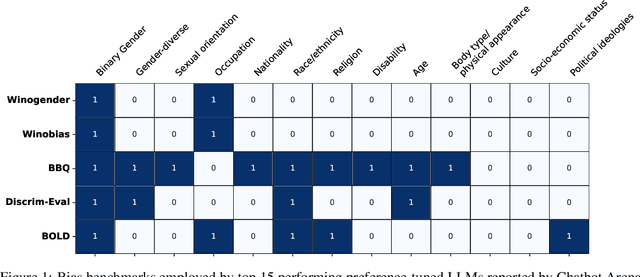
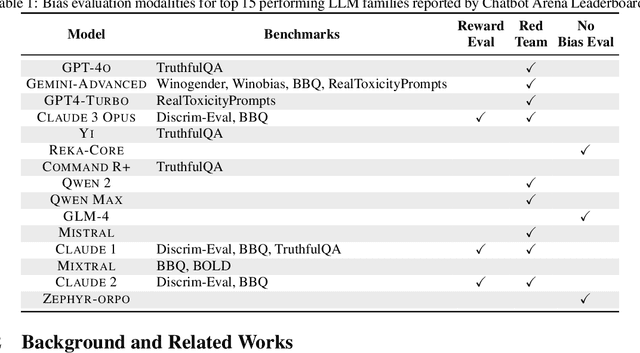
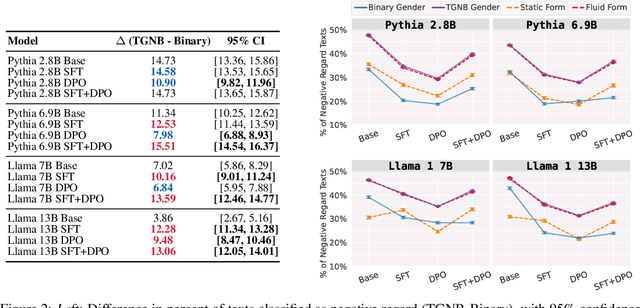

Abstract:Natural-language assistants are designed to provide users with helpful responses while avoiding harmful outputs, largely achieved through alignment to human preferences. Yet there is limited understanding of whether alignment techniques may inadvertently perpetuate or even amplify harmful biases inherited from their pre-aligned base models. This issue is compounded by the choice of bias evaluation benchmarks in popular preference-finetuned models, which predominantly focus on dominant social categories, such as binary gender, thereby limiting insights into biases affecting underrepresented groups. Towards addressing this gap, we center transgender, nonbinary, and other gender-diverse identities to investigate how alignment procedures interact with pre-existing gender-diverse bias in LLMs. Our key contributions include: 1) a comprehensive survey of bias evaluation modalities across leading preference-finetuned LLMs, highlighting critical gaps in gender-diverse representation, 2) systematic evaluation of gender-diverse biases across 12 models spanning Direct Preference Optimization (DPO) stages, uncovering harms popular bias benchmarks fail to detect, and 3) a flexible framework for measuring harmful biases in implicit reward signals applicable to other social contexts. Our findings reveal that DPO-aligned models are particularly sensitive to supervised finetuning (SFT), and can amplify two forms of real-world gender-diverse harms from their base models: stigmatization and gender non-affirmative language. We conclude with recommendations tailored to DPO and broader alignment practices, advocating for the adoption of community-informed bias evaluation frameworks to more effectively identify and address underrepresented harms in LLMs.
Pixtral 12B
Oct 09, 2024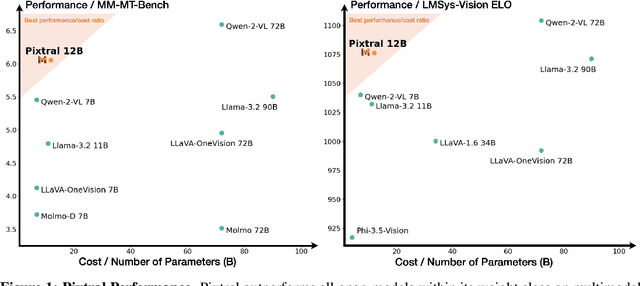
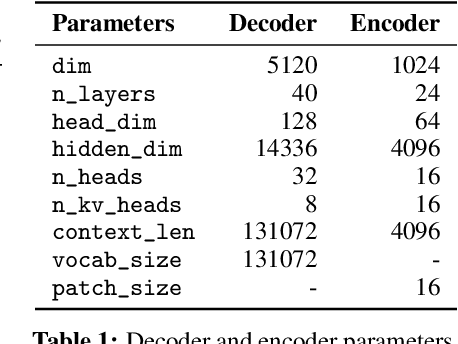
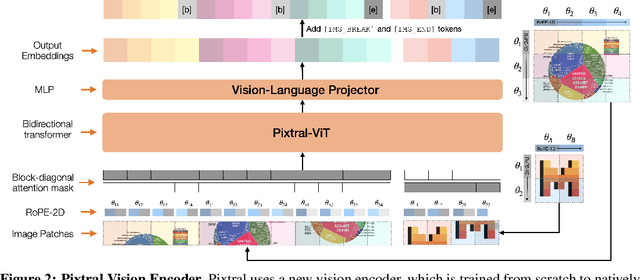
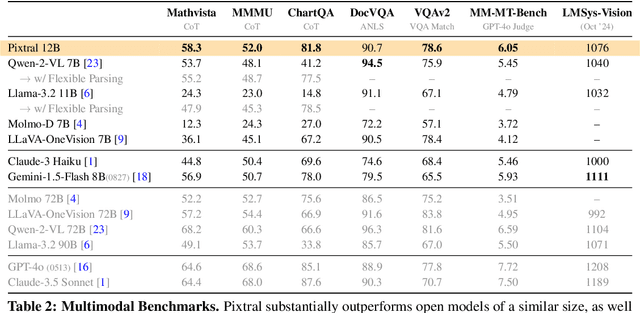
Abstract:We introduce Pixtral-12B, a 12--billion-parameter multimodal language model. Pixtral-12B is trained to understand both natural images and documents, achieving leading performance on various multimodal benchmarks, surpassing a number of larger models. Unlike many open-source models, Pixtral is also a cutting-edge text model for its size, and does not compromise on natural language performance to excel in multimodal tasks. Pixtral uses a new vision encoder trained from scratch, which allows it to ingest images at their natural resolution and aspect ratio. This gives users flexibility on the number of tokens used to process an image. Pixtral is also able to process any number of images in its long context window of 128K tokens. Pixtral 12B substanially outperforms other open models of similar sizes (Llama-3.2 11B \& Qwen-2-VL 7B). It also outperforms much larger open models like Llama-3.2 90B while being 7x smaller. We further contribute an open-source benchmark, MM-MT-Bench, for evaluating vision-language models in practical scenarios, and provide detailed analysis and code for standardized evaluation protocols for multimodal LLMs. Pixtral-12B is released under Apache 2.0 license.
The Llama 3 Herd of Models
Jul 31, 2024Abstract:Modern artificial intelligence (AI) systems are powered by foundation models. This paper presents a new set of foundation models, called Llama 3. It is a herd of language models that natively support multilinguality, coding, reasoning, and tool usage. Our largest model is a dense Transformer with 405B parameters and a context window of up to 128K tokens. This paper presents an extensive empirical evaluation of Llama 3. We find that Llama 3 delivers comparable quality to leading language models such as GPT-4 on a plethora of tasks. We publicly release Llama 3, including pre-trained and post-trained versions of the 405B parameter language model and our Llama Guard 3 model for input and output safety. The paper also presents the results of experiments in which we integrate image, video, and speech capabilities into Llama 3 via a compositional approach. We observe this approach performs competitively with the state-of-the-art on image, video, and speech recognition tasks. The resulting models are not yet being broadly released as they are still under development.
Towards Safety and Helpfulness Balanced Responses via Controllable Large Language Models
Apr 01, 2024Abstract:As large language models (LLMs) become easily accessible nowadays, the trade-off between safety and helpfulness can significantly impact user experience. A model that prioritizes safety will cause users to feel less engaged and assisted while prioritizing helpfulness will potentially cause harm. Possible harms include teaching people how to build a bomb, exposing youth to inappropriate content, and hurting users' mental health. In this work, we propose to balance safety and helpfulness in diverse use cases by controlling both attributes in LLM. We explore training-free and fine-tuning methods that do not require extra human annotations and analyze the challenges of controlling safety and helpfulness in LLMs. Our experiments demonstrate that our method can rewind a learned model and unlock its controllability.
Effective Long-Context Scaling of Foundation Models
Sep 27, 2023



Abstract:We present a series of long-context LLMs that support effective context windows of up to 32,768 tokens. Our model series are built through continual pretraining from Llama 2 with longer training sequences and on a dataset where long texts are upsampled. We perform extensive evaluation on language modeling, synthetic context probing tasks, and a wide range of research benchmarks. On research benchmarks, our models achieve consistent improvements on most regular tasks and significant improvements on long-context tasks over Llama 2. Notably, with a cost-effective instruction tuning procedure that does not require human-annotated long instruction data, the 70B variant can already surpass gpt-3.5-turbo-16k's overall performance on a suite of long-context tasks. Alongside these results, we provide an in-depth analysis on the individual components of our method. We delve into Llama's position encodings and discuss its limitation in modeling long dependencies. We also examine the impact of various design choices in the pretraining process, including the data mix and the training curriculum of sequence lengths -- our ablation experiments suggest that having abundant long texts in the pretrain dataset is not the key to achieving strong performance, and we empirically verify that long context continual pretraining is more efficient and similarly effective compared to pretraining from scratch with long sequences.
Code Llama: Open Foundation Models for Code
Aug 25, 2023
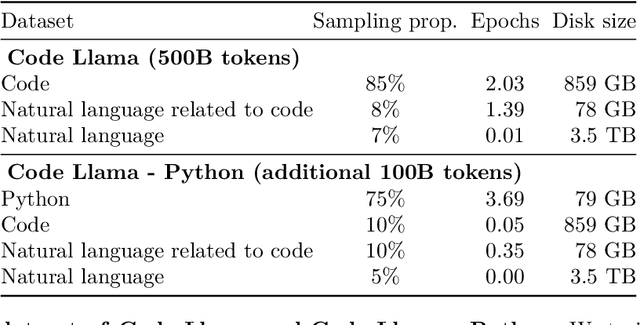

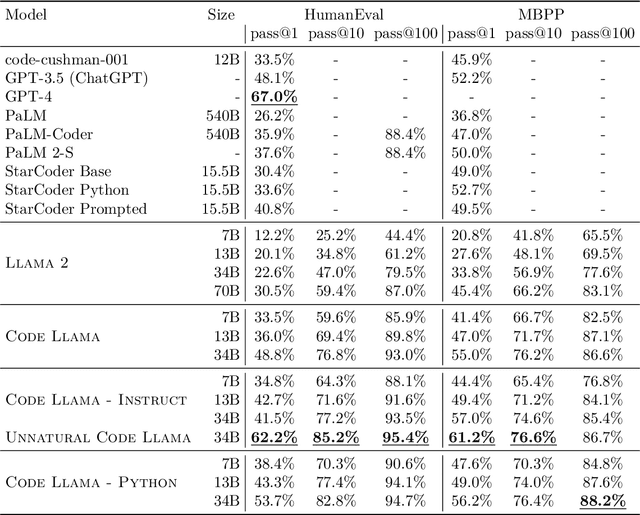
Abstract:We release Code Llama, a family of large language models for code based on Llama 2 providing state-of-the-art performance among open models, infilling capabilities, support for large input contexts, and zero-shot instruction following ability for programming tasks. We provide multiple flavors to cover a wide range of applications: foundation models (Code Llama), Python specializations (Code Llama - Python), and instruction-following models (Code Llama - Instruct) with 7B, 13B and 34B parameters each. All models are trained on sequences of 16k tokens and show improvements on inputs with up to 100k tokens. 7B and 13B Code Llama and Code Llama - Instruct variants support infilling based on surrounding content. Code Llama reaches state-of-the-art performance among open models on several code benchmarks, with scores of up to 53% and 55% on HumanEval and MBPP, respectively. Notably, Code Llama - Python 7B outperforms Llama 2 70B on HumanEval and MBPP, and all our models outperform every other publicly available model on MultiPL-E. We release Code Llama under a permissive license that allows for both research and commercial use.
Llama 2: Open Foundation and Fine-Tuned Chat Models
Jul 19, 2023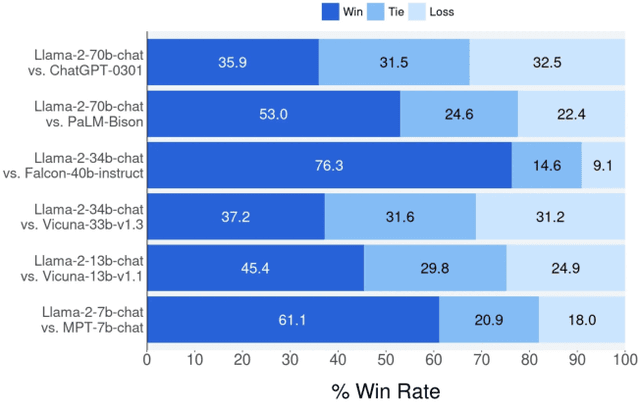

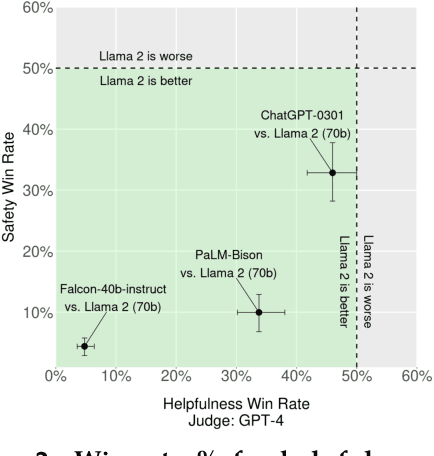

Abstract:In this work, we develop and release Llama 2, a collection of pretrained and fine-tuned large language models (LLMs) ranging in scale from 7 billion to 70 billion parameters. Our fine-tuned LLMs, called Llama 2-Chat, are optimized for dialogue use cases. Our models outperform open-source chat models on most benchmarks we tested, and based on our human evaluations for helpfulness and safety, may be a suitable substitute for closed-source models. We provide a detailed description of our approach to fine-tuning and safety improvements of Llama 2-Chat in order to enable the community to build on our work and contribute to the responsible development of LLMs.
Multilingual End to End Entity Linking
Jun 15, 2023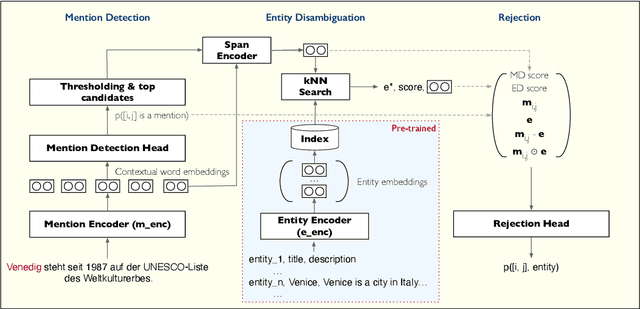



Abstract:Entity Linking is one of the most common Natural Language Processing tasks in practical applications, but so far efficient end-to-end solutions with multilingual coverage have been lacking, leading to complex model stacks. To fill this gap, we release and open source BELA, the first fully end-to-end multilingual entity linking model that efficiently detects and links entities in texts in any of 97 languages. We provide here a detailed description of the model and report BELA's performance on four entity linking datasets covering high- and low-resource languages.
Polar Ducks and Where to Find Them: Enhancing Entity Linking with Duck Typing and Polar Box Embeddings
May 19, 2023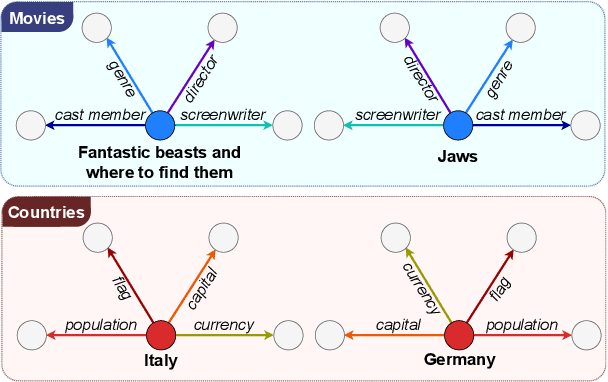
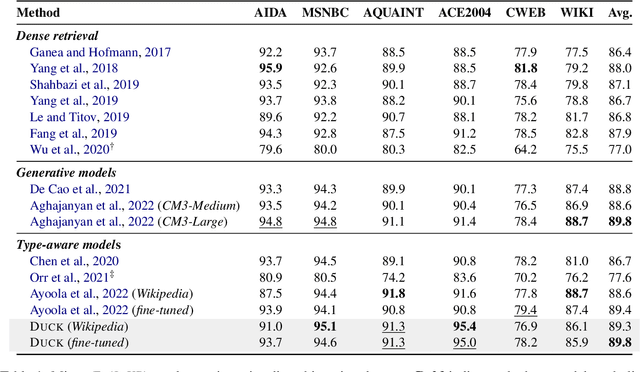

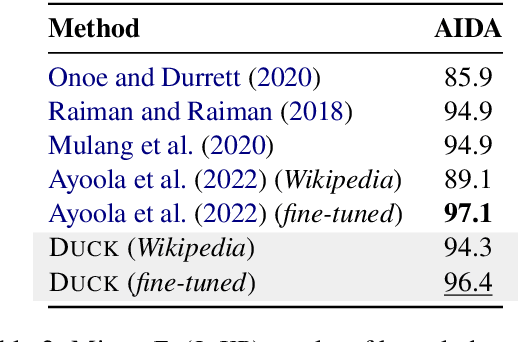
Abstract:Entity linking methods based on dense retrieval are an efficient and widely used solution in large-scale applications, but they fall short of the performance of generative models, as they are sensitive to the structure of the embedding space. In order to address this issue, this paper introduces DUCK, an approach to infusing structural information in the space of entity representations, using prior knowledge of entity types. Inspired by duck typing in programming languages, we propose to define the type of an entity based on the relations that it has with other entities in a knowledge graph. Then, porting the concept of box embeddings to spherical polar coordinates, we propose to represent relations as boxes on the hypersphere. We optimize the model to cluster entities of similar type by placing them inside the boxes corresponding to their relations. Our experiments show that our method sets new state-of-the-art results on standard entity-disambiguation benchmarks, it improves the performance of the model by up to 7.9 F1 points, outperforms other type-aware approaches, and matches the results of generative models with 18 times more parameters.
Entity Tagging: Extracting Entities in Text Without Mention Supervision
Sep 13, 2022



Abstract:Detection and disambiguation of all entities in text is a crucial task for a wide range of applications. The typical formulation of the problem involves two stages: detect mention boundaries and link all mentions to a knowledge base. For a long time, mention detection has been considered as a necessary step for extracting all entities in a piece of text, even if the information about mention spans is ignored by some downstream applications that merely focus on the set of extracted entities. In this paper we show that, in such cases, detection of mention boundaries does not bring any considerable performance gain in extracting entities, and therefore can be skipped. To conduct our analysis, we propose an "Entity Tagging" formulation of the problem, where models are evaluated purely on the set of extracted entities without considering mentions. We compare a state-of-the-art mention-aware entity linking solution against GET, a mention-agnostic sequence-to-sequence model that simply outputs a list of disambiguated entities given an input context. We find that these models achieve comparable performance when trained both on a fully and partially annotated dataset across multiple benchmarks, demonstrating that GET can extract disambiguated entities with strong performance without explicit mention boundaries supervision.
 Add to Chrome
Add to Chrome Add to Firefox
Add to Firefox Add to Edge
Add to Edge